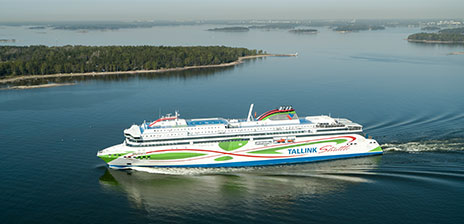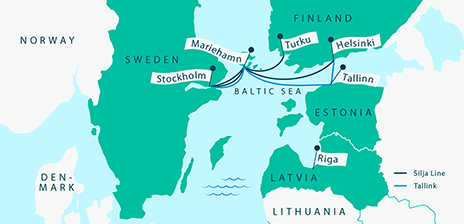ISPS AND PORT SECURITY
ISPS is an abbreviation for International Ship and Port Facility Security Code, a set of regulations intended to increase security at ports and onboard ships. The body behind the code is IMO (International Maritime Organization), ruled by the United Nations. The international ISPS code will come into force on 1 July 2004, with the following consequences for Silja and its customers:
- - Harbours will be fenced.
- - All units must be pre-booked to guarantee entry to the harbour.
- - Goods lists with separate itemisations of dangerous goods must be presented for all units.
- - Spending the night inside the fenced area (Secured Area) will be forbidden.
- - The authorities will have the right to carry out random checks on any cargo units.
The ISPS code defines security levels which relate to the security situation and any perceived threats. Security levels are set by each country's police authorities and may vary from port to port.
SECURITY LEVEL 1 (NORMAL SITUATION)
Security Level 1 is defined in the ISPS code as the basic or normal state. At this level, the goods list should be a transport document which specifies the consigner, consignee, total weight and classification of the shipped goods.
Trucks and vehicles accompanied by driver
All units must be pre-booked before they may be transferred into the Secured Area. This means that waiting vehicles must be booked at the check-in or remain outside the Secured Area. Drivers must present goods lists at the check-in. When the cargo contains dangerous goods, the transport documents must follow the IMDG/ADR regulations that are valid at the time. Pre-booked units that arrive early at the harbour to await a later departure may be parked within the Secured Area provided that their drivers leave the Secured Area. Drivers may not re-enter the Secured Area until before closing time of their departure. At the destination, the unit must leave the Secured Area immediately.
Goods to be handled (semi-trailers, containers, boats, pallets)
All units must be pre-booked. Unbooked units arriving at the harbour during the day must be booked before entry to the Secured Area. A goods list and a document detailing any dangerous goods in accordance with the regulations valid at the time must be presented before loading. Tractor-trailer drivers must leave the Secured Area after depositing their unit for loading.
SECURITY LEVEL 2 (RAISED LEVEL OF READINESS)
Security Level 2 indicates raised readiness in the ISPS code. At this level, by detailed goods list we mean a transport document that specifies the consigner, consignee, total weight and type of the goods, as well as the number of collies. By a transport worker's identification card we mean an ID card that proves the driver's identity and indicates the transport company he/she is employed by. The following instructions are valid in addition to the requirements specified for Security Level 1:
Trucks and vehicles accompanied by driver
Units must arrive at the harbour a minimum of two hours before departure. Drivers and any assistant drivers must prove their identity by presenting their transport worker's ID cards. Drivers must present detailed goods lists of their cargo at the check-in.
Goods to be handled (semi-trailers, containers, boats, pallets)
Units must arrive at the harbour a minimum of two hours before departure. In these cases tractor-trailer drivers must prove their identity and present detailed goods lists, including a document itemising any dangerous goods in accordance with regulations valid at the time.
SECURITY LEVEL 3
Security Level 3 indicates the highest level of readiness for threat situations defined in the ISPS code. This level is established at the threat of a bomb attack or other dangerous situation. At this level, goods are handled in accordance with authorities' orders.
Inspection of goods
During Security Level 1 the ISPS code provides random checking of the cargo. During Security Level 2 checking will be carried out more frequently. These inspections will be agreed separately with the relevant authorities.








